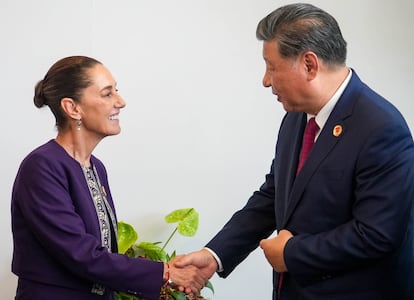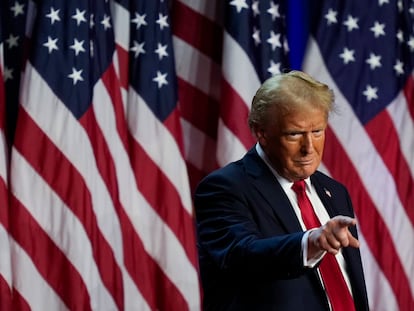China’s economic activity in Mexico could hurt renewal of trade agreement with US and Canada
The Sheinbaum administration’s relations with the Asian giant, particularly in the auto industry, is straining Mexico’s ties with its North American partners ahead of the 2026 USMCA review


The sovereignty that Mexico proclaims and Donald Trump’s autarky-inspired braggadoccio are already clashing with a world where geopolitics causes economies to be strongly intertwined. In the competitiveness that North America seeks, there is no room for flirtation with China, another one of the great poles of the global market. And that is the reason why Canada has turned against Mexico, whom it accuses of allowing the Asian giant to sneak through its borders bypassing the trilateral treaty, the USMCA. The assembly of cars with auto parts manufactured in China has not only revived the threat of tariffs by Trump, who is about to take up residence in the White House again; it has also made Canadian liberals raise their voices in a game that experts describe as “opportunistic,” given that Canadian elections are due next year and the rise of conservative views is suggesting the need for tougher messages. Mexico continues to be the weakest partner in the alliance, and according to international affairs experts, it cannot deviate from the path: its domestic well-being depends, more than anyone else, on its neighbors to the north.
“Mexico is indeed triangulating Chinese exports to the United States and Canada,” says Estefanía Cruz, from the UNAM Center for Research on North America. And the biggest alarm involves automaking, a key element in domestic and external economies. The United States, and now also Canada, will not tolerate having products manufactured by China enter their territories through Mexico, where those vehicles are assembled. And they will not accept the claim that Chinese plants planned in Mexico are exclusively meant to supply the Latin American market, not to export to the United States, as the Asian electric car company BYD has pointed out. “China is presenting itself as a hegemonic power that wants to have a presence in the Latin American market, but Mexico cannot be the tool for this,” says Pía Taracena, from the Universidad Iberoamericana. Perhaps Brazil or Argentina could instead, she suggests. “Mexico already has most of its eggs in the basket of the northern region, and breaking that would be very expensive,” she notes.
The review of the USMCA is scheduled for 2026, always with the threat of renegotiation in the background. The trade agreement is the tool with which the three North American countries protect themselves as a competitive bloc at a global level and ward off China’s advance. “It is not in the interest of any of the three to break the agreement,” says Taracena, “but Mexico is the one who would lose out the most, so bilateral agreements and continuing to flirt with China are not in its interest,” she says. “Since [former Mexican president] Porfirio Díaz (1876-1911), there has been talk of diversifying the economy, but China causes problems, the national interest lies with North America,” she adds.
Mexico depends on cheap Chinese manufactured goods for its household appliances, cell phones, pharmaceutical ingredients and fertilizers, but it will have to “guarantee that this trade is not triangulated with the United States, but rather remains in the domestic market,” Cruz says. This expert suggests that Mexico would do well to push the treaty negotiations until late 2026, when the United States is due to hold midterm elections that could change the makeup of Congress, which is where the review of the treaty must be ratified.
Elections are always a key factor in interpreting international messages, and Canada will elect its new prime minister in 2025. “The country is losing its native population, young people are looking for well-paid jobs elsewhere,” says Cruz, and the conservatives are, for now, gaining ground in the polls. It is therefore not surprising that the Liberals’ message, with Prime Minister Justin Trudeau at the helm, is adopting conservative overtones. Canada is aligning itself with the United States, in a position “that is not temporary, but consistent since the United States declared a trade war on China in Trump’s first term,” explains Cruz. But in addition, the Canadian prime minister is trying to avoid pressure from his country’s conservatives, who are angry with Mexico. Mining is emerging as one of the battlefields here. “Mexico has changed the rules of the game with judicial and energy reform, and this response from Canada has to do with the pressures from its mining sector, which also experiences high levels of insecurity in Mexico,” explains Taracena. “Mexico must lobby hard to show that things are not as these [industrial] groups say,” says the expert.
Claudia Sheinbaum’s new government team in Mexico, with Marcelo Ebrard at the head of the Economy and Juan Ramón de la Fuente in the Foreign Ministry, will have to be extremely careful about relations with China and demonstrate just how far the Asian country’s investments reach and what they are going to do about it, say the experts. “It is a sensitive issue,” says Taracena.
Canada and Mexico are both concerned about the relocation of U.S. companies to their territories, in a widely covered trend called nearshoring, “but they are not competing for the same sectors; Canada is more interested in nanochips and Mexico in commonly used semiconductors,” says Cruz. “Canada also hopes to receive biomedical and technology companies,” which is why Trudeau is in the right place, next to Trump. “Rather than fear of an internal electoral setback, he is being opportunistic,” says Cruz. In any case, relations between Mexico and Canada have also flowed under conservative governments, she notes. There is no reason for Canada to try to keep Mexico out of the regional agreement that the three countries now maintain.
Sign up for our weekly newsletter to get more English-language news coverage from EL PAÍS USA Edition
Tu suscripción se está usando en otro dispositivo
¿Quieres añadir otro usuario a tu suscripción?
Si continúas leyendo en este dispositivo, no se podrá leer en el otro.
FlechaTu suscripción se está usando en otro dispositivo y solo puedes acceder a EL PAÍS desde un dispositivo a la vez.
Si quieres compartir tu cuenta, cambia tu suscripción a la modalidad Premium, así podrás añadir otro usuario. Cada uno accederá con su propia cuenta de email, lo que os permitirá personalizar vuestra experiencia en EL PAÍS.
¿Tienes una suscripción de empresa? Accede aquí para contratar más cuentas.
En el caso de no saber quién está usando tu cuenta, te recomendamos cambiar tu contraseña aquí.
Si decides continuar compartiendo tu cuenta, este mensaje se mostrará en tu dispositivo y en el de la otra persona que está usando tu cuenta de forma indefinida, afectando a tu experiencia de lectura. Puedes consultar aquí los términos y condiciones de la suscripción digital.
More information
Archived In
Últimas noticias
Chris Martin, Taylor Swift, Elijah Wood and other famous wedding ‘crashers’
‘How does it feel to be a failure?’: Elizabeth Berkley’s journey from ‘Showgirls’ ridicule to vindication
The story of the Málaga virus: The code that haunted Google’s cybersecurity center director for 30 years
The impact of Ecuador’s mega-prison: A polluted river, cleared forests and military checkpoints
Most viewed
- Christian Louboutin: ‘Young people don’t want to be like their parents. And if their parents wear sneakers, they’re going to look for something else’
- The low-cost creative revolution: How technology is making art accessible to everyone
- Liset Menéndez de la Prida, neuroscientist: ‘It’s not normal to constantly seek pleasure; it’s important to be bored, to be calm’
- All the effects of gentrification in one corner of Mexico’s Colonia Roma
- December Social Security and SSI payments: Dates, double checks and the 2026 COLA increase










































